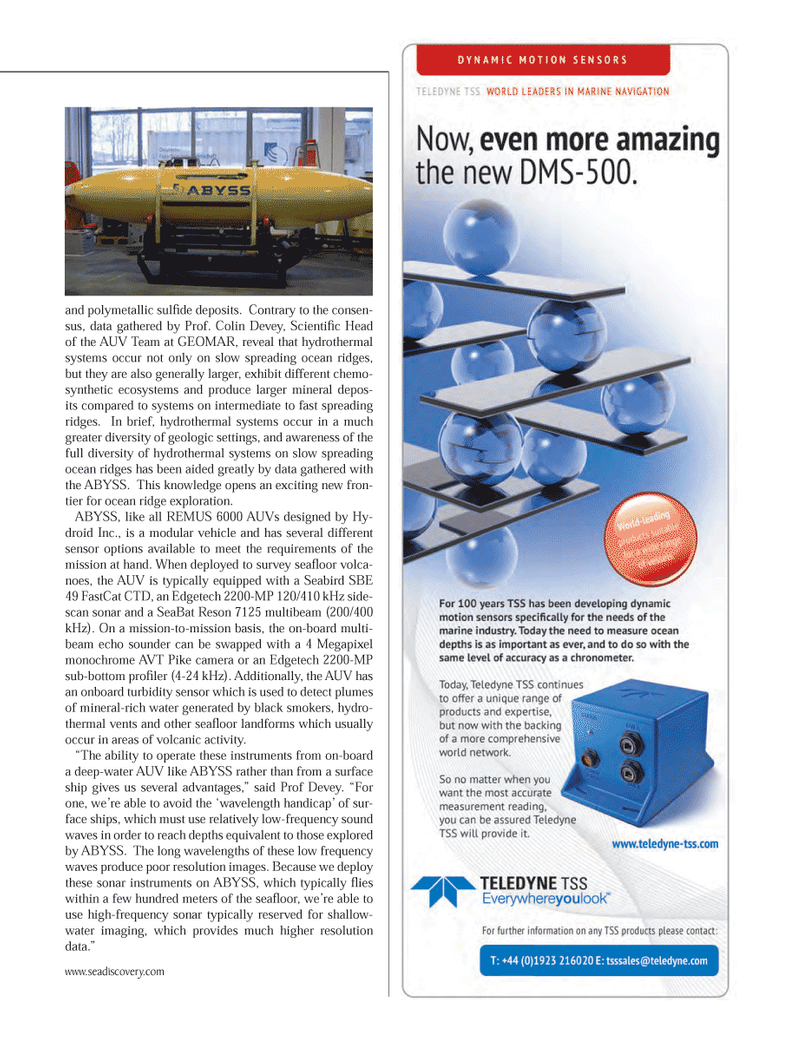
Page 21: of Marine Technology Magazine (May 2013)
Hydrographic Survey
Read this page in Pdf, Flash or Html5 edition of May 2013 Marine Technology Magazine
and polymetallic sulÞ de deposits. Contrary to the consen- sus, data gathered by Prof. Colin Devey, ScientiÞ c Head of the AUV Team at GEOMAR, reveal that hydrothermal systems occur not only on slow spreading ocean ridges, but they are also generally larger, exhibit different chemo- synthetic ecosystems and produce larger mineral depos- its compared to systems on intermediate to fast spreading ridges. In brief, hydrothermal systems occur in a much greater diversity of geologic settings, and awareness of the full diversity of hydrothermal systems on slow spreading ocean ridges has been aided greatly by data gathered with the ABYSS. This knowledge opens an exciting new fron- tier for ocean ridge exploration. ABYSS, like all REMUS 6000 AUVs designed by Hy- droid Inc., is a modular vehicle and has several different sensor options available to meet the requirements of the mission at hand. When deployed to survey seaß oor volca- noes, the AUV is typically equipped with a Seabird SBE 49 FastCat CTD, an Edgetech 2200-MP 120/410 kHz side- scan sonar and a SeaBat Reson 7125 multibeam (200/400 kHz). On a mission-to-mission basis, the on-board multi-beam echo sounder can be swapped with a 4 Megapixel monochrome AVT Pike camera or an Edgetech 2200-MP sub-bottom proÞ ler (4-24 kHz). Additionally, the AUV has an onboard turbidity sensor which is used to detect plumes of mineral-rich water generated by black smokers, hydro- thermal vents and other seaß oor landforms which usually occur in areas of volcanic activity. ÒThe ability to operate these instruments from on-board a deep-water AUV like ABYSS rather than from a surface ship gives us several advantages,Ó said Prof Devey. ÒFor one, weÕre able to avoid the Ôwavelength handicapÕ of sur- face ships, which must use relatively low-frequency sound waves in order to reach depths equivalent to those explored by ABYSS. The long wavelengths of these low frequency waves produce poor resolution images. Because we deploy these sonar instruments on ABYSS, which typically ß ies within a few hundred meters of the seaß oor, weÕre able to use high-frequency sonar typically reserved for shallow- water imaging, which provides much higher resolution data.Ó www.seadiscovery.com MTR #4 (18-33).indd 21MTR #4 (18-33).indd 215/6/2013 10:52:42 AM5/6/2013 10:52:42 AM

 20
20

 22
22
